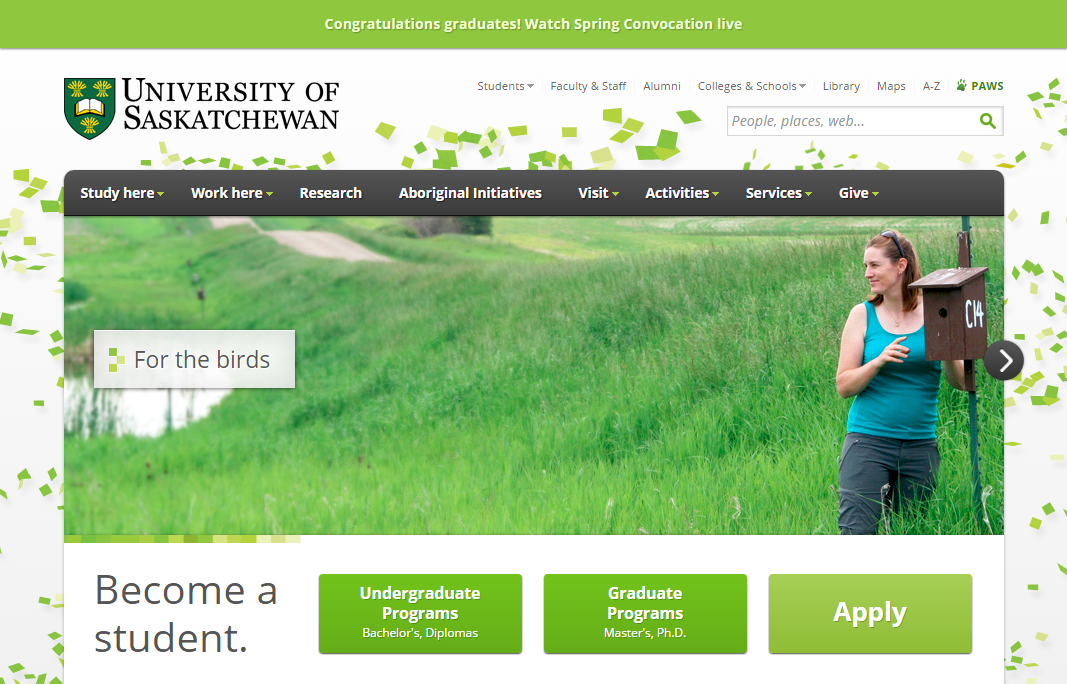
Region : Saskatchewan
City : Saskatoon
Web site : www.usask.ca
The University of Saskatchewan (U of S) is a Canadian public research university, founded in 1907, and located on the east side of the South Saskatchewan River in Saskatoon, Saskatchewan, Canada. An "Act to establish and incorporate a University for the Province of Saskatchewan" was passed by the provincial legislature in 1907. It established the provincial university on April 3, 1907 "for the purpose of providing facilities for higher education in all its branches and enabling all persons without regard to race, creed or religion to take the fullest advantage". The University of Saskatchewan is the largest education institution in the Canadian province of Saskatchewan. It is also the only Canadian University that has a partnership agreement with University of Oxford. The University of Saskatchewan is one of Canada?s top research universities (based on the number of Canada Research Chairs) and is a member of the U15 Group of Canadian Research Universities (the 15 most research-intensive universities in Canada).
The university began as an agricultural college in 1907 and established the first Canadian university-based department of extension in 1910. There were 120 hectares (300 acres) set aside for university buildings and 400 ha (1,000 acres) for the U of S farm, and agricultural fields. In total 10.32 km2 (3.98 sq mi) was annexed for the university. The main University campus is situated upon 981 ha (2,425 acres), with another 200 ha (500 acres) allocated for Innovation Place Research Park. The University of Saskatchewan agriculture college still has access to neighbouring urban research lands. The University of Saskatchewan's Vaccine and Infectious Disease Organization (VIDO) facility, (2003) develops DNA-enhanced immunization vaccines for both humans and animals. The University is also home to the Canadian Light Source synchrotron, which is considered one of the largest and most innovative investments in Canadian science. Since its origins as an agricultural college, research has played an important role at the university. Discoveries made at the U of S include sulphate-resistant cement and the cobalt-60 cancer therapy unit. The university offers over 200 academic programs. Duncan P. McColl was appointed as the first registrar, establishing the first convocation from which Chief Justice Edward L. Wetmore was elected as the first chancellor. Walter Charles Murray became the first president of the university's board of governors.
University of Saskatchewan ranks among the top ten in medical doctoral universities in Canada according to Maclean's Guide to Canadian Universities, the most notable ranking for the universities in Canada. As per 2013 Maclean's Ranking, this University becomes 9th among the Canadian Universities which offers a broad range of PhD programs and have medical schools and 10th among the universities which are largely focused on undergraduate education.
As per Shanghai Academic Ranking for World universities, one of the most notable rankings in the world, in 2013, the University of Saskatchewan ranks 151-200 in the world in Engineering/Technology and Computer Sciences subjects and 201-300 among all institutions in the world. The College of Engineering excellence was portrayed internationally with the University of Saskatchewan Space Design Team (USST) multiple first finishes at the X-Prize Foundation NASA challenges. The team was composed of undergraduate students, graduate students, faculty, and researchers drawn from across multiple disciplines. These finishes included world records in wireless energy transfer and space robotics technologies with features on Discovery Channel.
As per QS ranking 2013, the university stands 51-100 in Agriculture & Forestry and 151-200 in Education and Training, Geography, Engineering and Pharmacy.
The National Post and Financial Post "Top 500" ranking of Universities places the U of S 13th of the top 20 Canadian Universities with a population of 15,397 and revenue of $566,596,000. The Sidhpur Foundation places the University of Saskatchewan at spot 14 out of the top 25 universities in Canada. The Gourman Report Ranking of Canadian Universities gave the U of S a score of 3.28, which places it at spot 20 out of 60 Canadian Universities. The Globe and Mail's University Report Card reflects the opinions of 25,000 current undergraduates who responded to some 100 questions about their respective universities. The University of Saskatchewan received scores between B+ and A+ in the following categories
The University of Saskatchewan offers a wide variety of programs and courses. Agriculture and Bioresources, Arts and Science, Biotechnology, Edwards School of Business, Dentistry, Education, Engineering, Graduate and Postdoctoral Studies, Kinesiology, Law, Medicine, Nursing, Pharmacy and Nutrition, Physical Therapy and Veterinary Medicine.
In addition, the University's affiliated colleges and Centre for Continuing and Distance Education offer degree programs, certificates, and training programs. Many affiliated colleges allow students to complete the first two years of a Bachelor of Science or Bachelor of Arts degree, and some offer full degrees in Education, Native Studies, and Theology.
Sources : Wikipedia, www.usask.ca